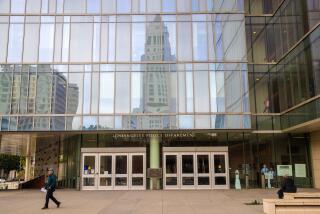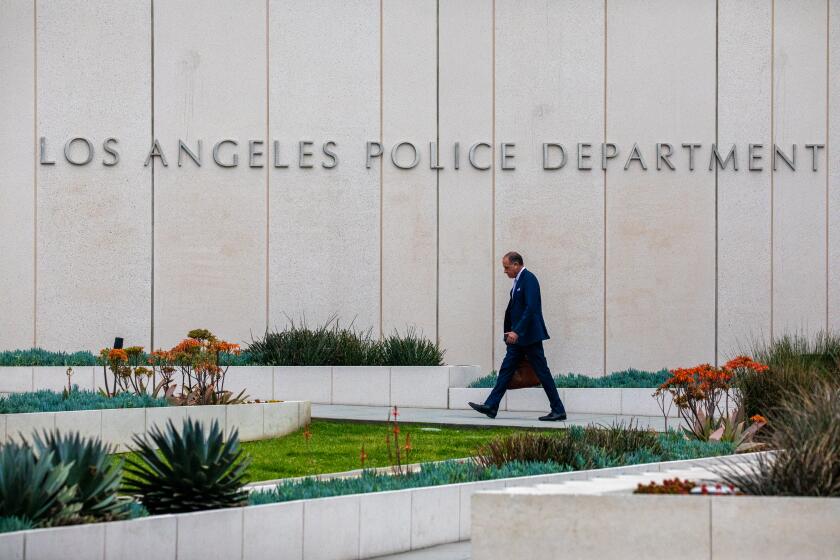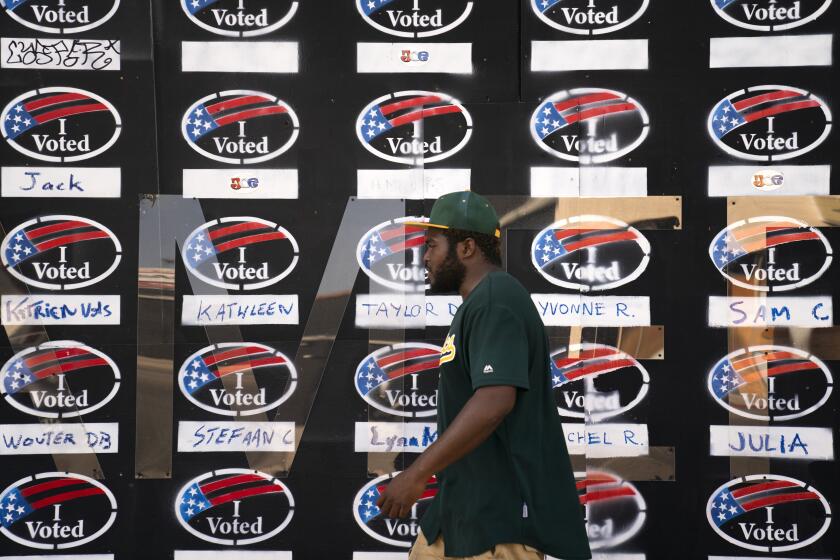Caught in the Cross-Fire : Residents Struggle to Protect Their Families Amid a Decade-Old Asian-Latino Gang War
The two young gangsters have never met, and yet given the chance they would probably try to kill each other.
One belongs to Long Beach’s biggest Mexican gang. He’s a spindly 15-year-old who talks about defending his race with a gun tucked into his trousers.
The other is a 17-year-old Cambodian who dropped out of school after seventh grade and joined a gang he hoped would protect him against “the Mexicans.”
Although they still have peach fuzz on their faces, the two are seasoned soldiers in a racially charged gang war pitting Latinos against Asians on the streets of central and northern Long Beach--a conflict that has claimed at least 36 lives in the five years that police have been documenting the killings.
The death toll includes three innocent Latino victims--ages 15 to 19--from Los Angeles who were gunned down May 15 in front of stunned witnesses, just moments after leaving a birthday party near MacArthur Park where they had gone to promote their dance club.
Two teen-age Laotian gang members have been charged with three counts of murder and three counts of attempted murder in the incident, which left three other Latinos seriously wounded.
The brazen attack drew a chorus of condemnation across Long Beach. But to those who live in the city’s meanest neighborhoods, it served only as a reminder of the unending gang violence over the years that has maimed countless victims, terrified residents and deepened resentment that may never heal.
The shootings have left parents searching for ways to protect their families. Some have pulled their children out of school because of brawls and stabbings on campus. Others have taken even more extreme action, sending their sons back to Mexico in hopes of keeping them alive.
“Families don’t know where to turn,” said Olivia Herrera, an activist whose son was killed earlier this year in a shooting that police believe was carried out by Asian gang members. “The community is fear-ridden. Somehow, we have to pull things together.”
The two sides in this war readily blame each other for starting the trouble. Both camps refuse to back down, instead speaking of the need to avenge their fallen brothers.
Latino gang members say they fight to protect their barrios--their pride--against Asians intruding on their streets.
“You’re backing up your race, so people won’t think Mexicans are punks,” said the defiant 15-year-old Latino, who proudly displays a twisted bullet wound on his stomach and a dime-sized nick on his hand like badges of honor.
*
Although the stomach wound nearly left him dead a year ago, the eighth-grader remains defiant. “The Chinos are gonna lose,” he said, referring to Asian gangs. “They’re not as powerful as the Mexicans.”
Latino gangs, who are primarily Mexican American, have deep roots in Long Beach. In some families, successive generations have joined up since the late 1960s, when Latinos started banding together in part to protect themselves against attacks by more dominant Latino gangs from other cities.
Today, there are more than 5,000 Latino gang members in Long Beach, almost half the city’s gang population, according to a recent city report.
By contrast, Asian gangs cropped up in Long Beach only a decade ago. Their emergence coincided with the influx of Southeast Asian refugees. The Asian gangsters--who are mostly Cambodian but also include Laotians, Vietnamese, Chinese and other groups--say they formed gangs as protection against attacks by their more numerous Latino rivals. Now, there are about 2,000 Asian gang members, according to the report.
“I’d walk on the street and they’d jump me,” said the 17-year-old Cambodian, who joined his gang about two years ago and has a quarter-sized bullet wound on one of his calves. Now “I call my homies. If I can’t do nothin’ about it, my homies can.”
Social workers say the young Asians mimicked their rivals’ lingo, graffiti, baggy clothing, tattoos and buzz haircuts--irritating the existing Latino gangs who viewed the newcomers as wanna-bes.
By organizing, the Asian youths gained power not only to challenge their rivals but also to shake down residents and businesses in their own community, activists and police say.
“Being in a gang made them feel important, respected,” said Leakhena Nou, a Cambodian social worker. “And they do get the respect, because people are intimidated by them.”
*
In one sense, the gang war in Long Beach is no different from violence tearing at other cities where gangs regularly trade insults and gunfire to settle vendettas. But gang counselors and police see a disturbing trend in Long Beach: A conflict that began as a struggle over turf has deteriorated into an intractable race war. Now, killings are increasingly motivated by hate, with Asians and Latinos shooting one another on sight.
“You’re walking down the street and see your enemy. You either beat him up or shoot him,” said a 14-year-old Cambodian gang member who boasts of many fights with Latino rivals. “It’s a game you play, but a reality game.”
One Latino gang member, a 21-year-old who said he now refrains from violence, offered an equally nonchalant attitude shared by many of his fellow gangsters. “If I would be gangbanging, I would be blasting a lot of the Chinos,” he said. “If you live in the gang life, you gotta die in it.”
Gang counselors say the battling has turned into an old grudge.
“At this point, I think some of the younger kids don’t know why they are fighting,” said Thomas M. White, coordinator of the city’s gang prevention program.
At the crux of the problem is a deep cultural divide. While rivals may live next door to one another in crowded neighborhoods, they are separated by an ocean of differences--from language and religion to food and music.
Latino gang members refer derogatorily to all Asian gang members, regardless of origin, as “the Chinos.” For their part, Asian gangsters know all Latinos as “the Mexicans.”
Tension between the two groups dates back to the early 1980s, shortly after thousands of Cambodians fleeing their war-torn country began arriving in Long Beach.
Many refugees came here to join family, after spending their lives in rural areas, living in bamboo huts without running water or electricity. Here, they moved into poor, urban neighborhoods around Anaheim Street that had been home to Latinos and African Americans for years.
Slowly the newcomers got a foothold--learning English, pooling their money, founding religious centers, and eventually opening businesses. Today, various estimates place their Long Beach population at 45,000 to 60,000. Their presence on Anaheim Street is well pronounced--with restaurants, grocery stores, jewelers and other shops--and some Cambodian residents envision the thoroughfare as a sort of Little Phnom Penh.
*
Perhaps the most enduring symbol of change has taken place in the very building that once housed the community’s main Latino social service agency, Centro de la Raza. The now-defunct agency moved from its Anaheim Street building in the early 1980s to a site closer to downtown Long Beach. A few years later, the nonprofit group United Cambodian Community Inc. moved into the building and made sweeping renovations, including a new facade reminiscent of Buddhist temples.
Today, the building is home to organizations and businesses that serve the Southeast Asian community as well as a job placement center open to all low-income residents of Long Beach.
Some in the Latino community resent the fact that Cambodians occupy the building and also express frustration at Cambodian business successes. Others complain about the newcomers depleting already limited social and medical services in the community.
“The Cambodians displaced the Latinos,” said one gang counselor who works in both communities. “The adults were angry, and the youth acted that anger out.”
The violence that has spilled into the streets has sent frightened residents scurrying for answers and safety. Many now keep their children home at night because the streets have become so dangerous.
Emma and Jose Sandoval sent their 14-year-old son, Ignasio,back to their native Mexico to live with their oldest son last fall after Ignasio was stabbed in the back and stomach and shot in the head near their old apartment at 14th Street and Cherry Avenue. Ignasio, who was not in gangs, still carries the bullet in his skull. Doctors said it was too dangerous to remove.
“I didn’t want him dead,” Emma Sandoval, 41, said of the difficult decision to part with her son. “He said to me, ‘If you don’t send me (to Mexico), they will finish me off.’ He was so traumatized. I don’t think he’ll ever come back.”
*
Sandoval worries about the safety of her seven other children. Another son, 19-year-old Joel, was nearly run down recently by suspected Asian gang members, she said. He has rejected attempts to send him to Mexico, saying he wants to remain to help provide income for the family. Sandoval says she doesn’t know why her sons were targeted.
Community leaders say that countless families such as the Sandovals are caught in the middle of the gang violence with nowhere to turn.
“People can’t relax in front of their homes anymore because they’re wondering if they are gonna catch a stray bullet,” said Ernie Natividad, a counselor with Victory Outreach Long Beach, a church that ministers to gang members. “There’s a lot of fear.”
That fear extends to school campuses, where racial tensions occasionally boil over.
At Jordan High School in North Long Beach, a city police officer and school district security guard--both armed--spend their days trying to maintain calm between Latino and Asian students, who have gotten into numerous fights over the years.
One Latino parent recently moved her family to the city’s eastside to seek a safer neighborhood but has since pulled her 13-year-old son from school after he was jumped twice on campus by Asian rivals who were bused to the school.
Amelia Nieto’s son, who asked not to be named, was suspended after a recent fight with an Asian rival in which he suffered minor injuries. Nieto said her son, who is not in a gang, could not concentrate on classes because of the troubles.
“Something’s not right,” said Nieto, 42. “Kids have to watch their backs and still pay attention to the teacher. I think home study is really the best way for him. I feel like it is safer and he will learn a lot more.”
*
Latino and Asian activists say the city should have prepared better for the racial tensions that exist today--pushing for cultural awareness classes in schools, establishing a dialogue between groups and seeking more racial diversity on the police force.
Of the police department’s 762 sworn officers on May 1, there were 561 whites, 113 Latinos, 52 African Americans, 31 Asians and five Native Americans.
Police Chief William C. Ellis said the police department is making efforts to recruit more minority officers, but added that police alone cannot be expected to solve a complex problem that involves schools, families and other factors.
The activists and even some frustrated city officials, meanwhile, complain that City Hall has ignored the gang problem over the years because the violence hasn’t yet spread into affluent parts of the city.
“I think the city has been in denial that a gang problem even exists,” said Councilwoman Doris Topsy-Elvord, a former county probation officer whose central Long Beach district includes many gang-infested neighborhoods. “For years, this city didn’t even want to recognize it, but I had (gang members) in Long Beach on my caseload.”
Critics say the city examines its gang problems only when high-profile incidents push the issue to the surface. After the shootings of the three Latinos last month, police blanketed known gang areas temporarily to catch the suspects and to quell further violence. City Manager James C. Hankla ordered the city Human Relations Commission to hold hearings on the Asian-Latino rift and other gang problems.
*
But community activists say a police crackdown will not bring peace to the streets in the long run. And they criticize the commission for failing to invite enough young people to the hearings, which were held outside the central city communities most affected by the gang war.
The commissioners point to the good they expect out of their recent meetings. At their urging, the City Council approved emergency recreation programs for the summer that will include city vehicles that bring sports equipment, board games and other activities to parks. The commission plans to hold further meetings on gang problems and will issue a final report to the council this fall.
Deputy City Manager Joe Rouzan, who coordinates the city’s response to gangs, conceded that officials were slow to respond to the gang violence initially, partly because leaders hadn’t expected tensions to flare between Latinos and Asians.
But Rouzan said the recent commission meetings are only the latest effort to address the gang troubles. In recent years, the city also has hired more police and formed athletic leagues for inner-city youths, among other things, he said.
Rouzan heads a new task force that is examining the effectiveness of various anti-gang programs run by the city and other organizations. Next month, the task force, which includes police, youths, school district officials, court officials and others, will list anti-gang programs that deserve the most funding, he said.
Some police and gang counselors question whether the city’s efforts will have any impact on gang members who feel shunted by adult authorities and care little about official edicts.
“All the meetings in the world aren’t going to make a bit of difference if you’ve got a 15-year-old running around at 10 o’clock at night with an Uzi in his hand and killing on his mind,” said Long Beach police Sgt. Jim Bisetti, who oversees a joint gang task force with the FBI.
City leaders, police and community activists appear to agree on one point: Any solution will have to include grass-roots organizations that work closely with the gangs. Some counselors on the street say that real change will ultimately rest with the families and religious institutions that play a dominant role in the Latino and Asian communities.
*
Yet even a dedicated corps of counselors and pastors will have a difficult time putting an end to the gang war because of the racial animosity that divides the sides and fuels the violence, activists warn.
Gang members themselves scoff at notions of peace, and are reluctant to consider a truce like the one that has helped bring a tentative peace among some African American gangs in Watts. The young gang members in Long Beach are prepared to continue the battle, they say, even if it means their own lives.
“We’re not gonna let ‘em shoot us,” said the 17-year-old Cambodian gang member with the bullet wound on his calf. “If they do, we’ll shoot them back.”
Profiles of City’s Asian, Latino Gangs
LATINOS Gangs: 27 Members: 5,200+ Membership: Predominantly Mexican American, but includes Salvadorans, Guatemalans and others from Central America. First formed: Late 1960s. Reason: Protect against dominant Latino gangs in other cities.
ASIANS Gangs: 35 Members: 2,000+ Membership: Mostly Cambodian, but includes Vietnamese, Laotians, Chinese and Pacific Islander groups such as Samoans and Filipinos. First formed: Mid-1980s. Reason: Protect against attacks by Latino rivals.
Sources: Long Beach Gang Prevention Program, Asian and Latino community workers.
More to Read
Sign up for Essential California
The most important California stories and recommendations in your inbox every morning.
You may occasionally receive promotional content from the Los Angeles Times.










